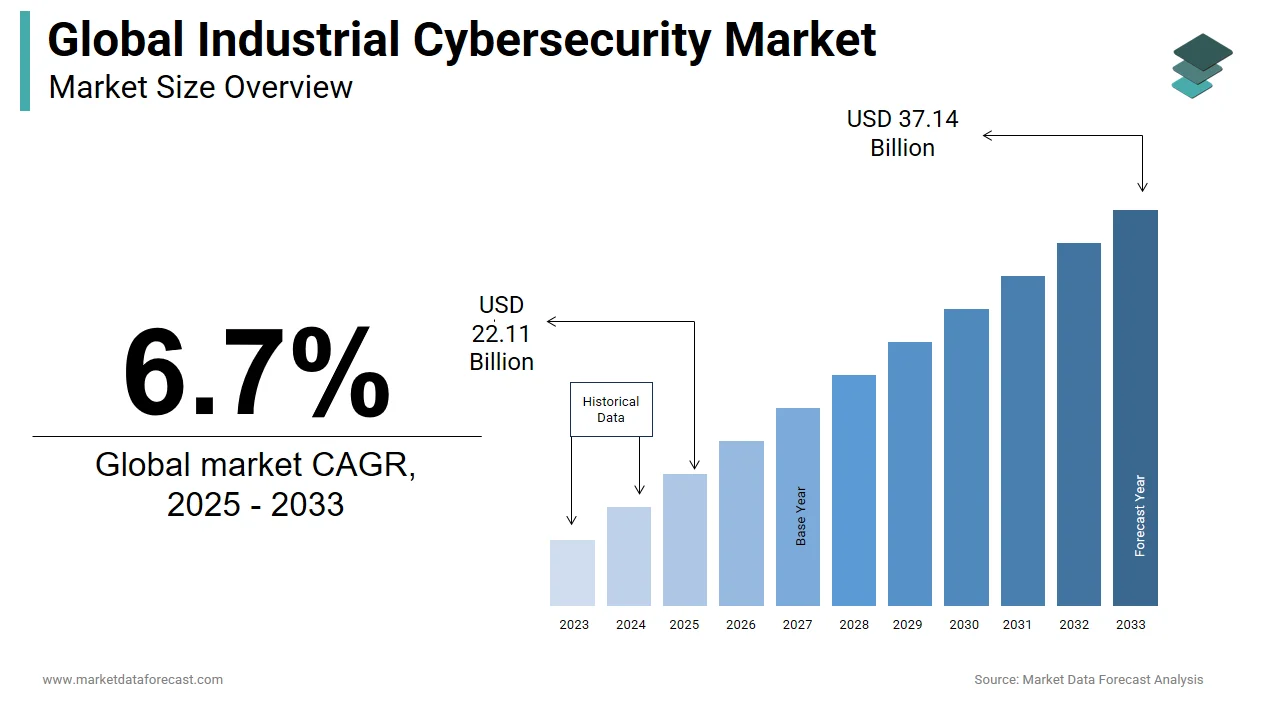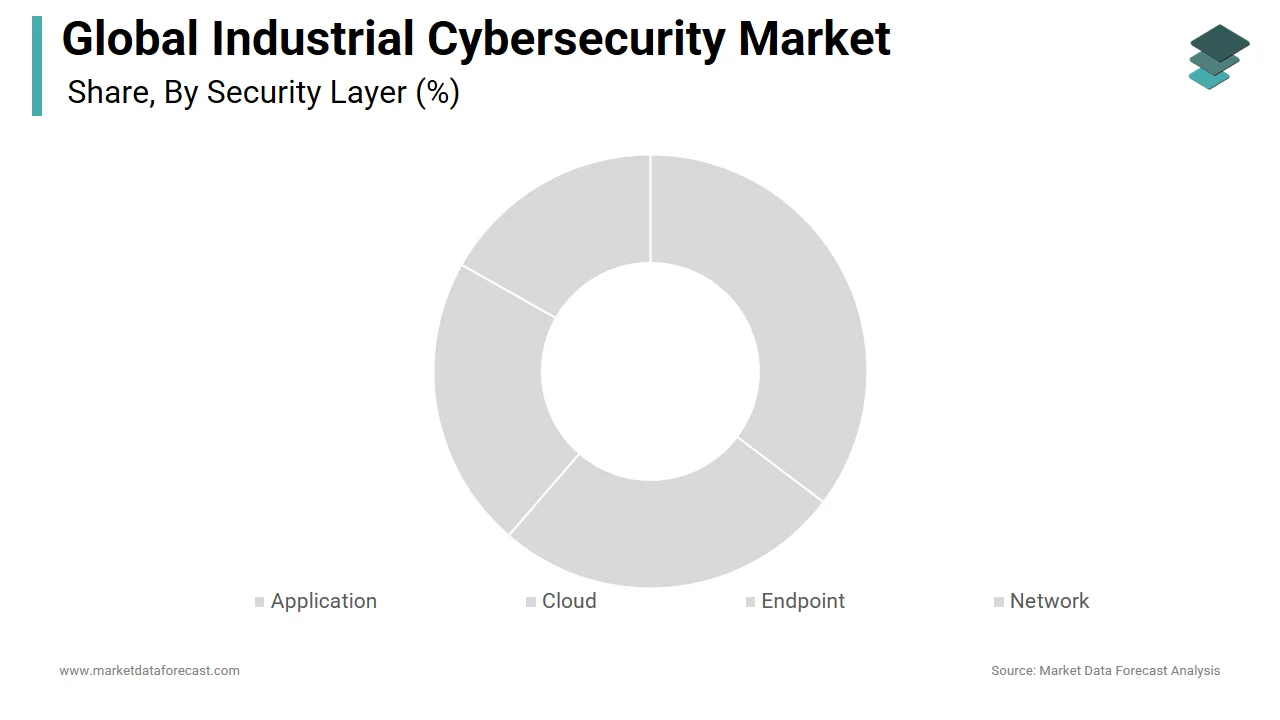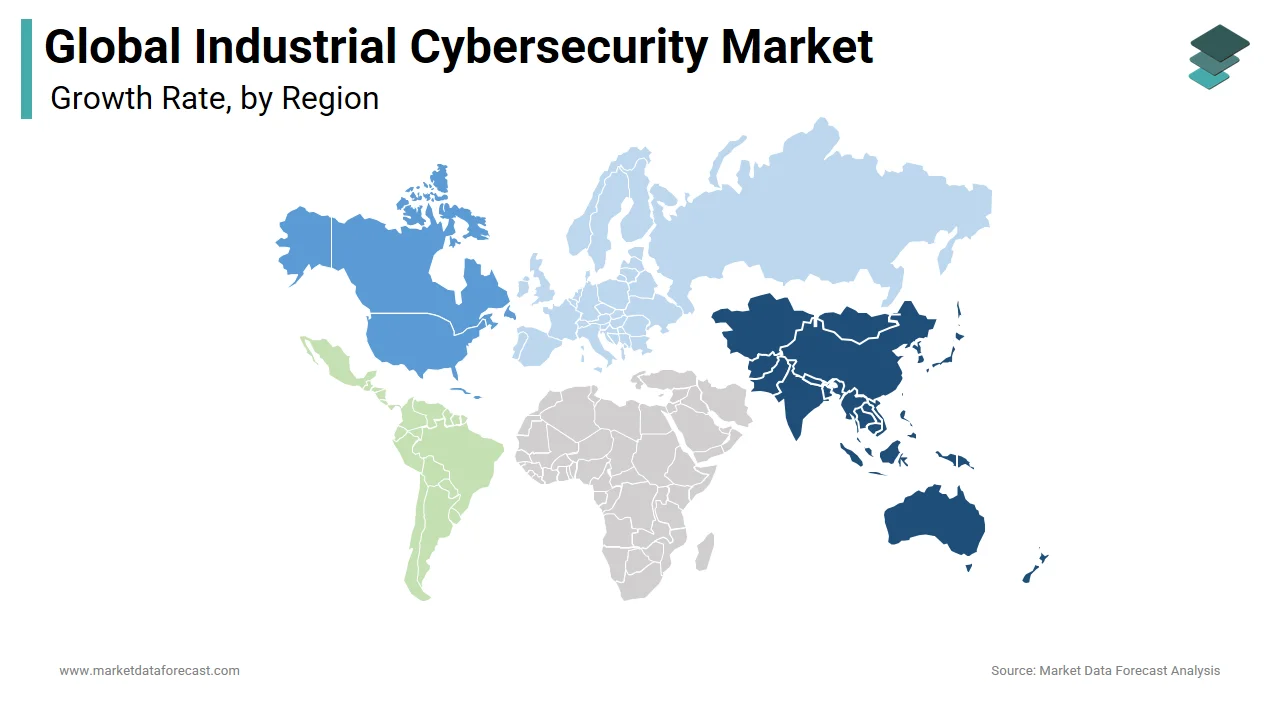Global Industrial Cybersecurity Market Size, Share, Trends, & Growth Forecast Report by Component (Hardware Solutions, Software Solutions and Services), Security Layer (Network Security, End-point Security, Cloud Security and Application Security), End User (Process Industries and Discrete Industries) and Region (North America, Europe, Asia-Pacific, Latin America, Middle East and Africa), Industry Analysis From 2025 To 2033.
Global Industrial Cybersecurity Market Size
The global industrial cybersecurity market was worth USD 20.72 billion in 2024. The global market is expected to reach USD 22.11 billion in 2025 and USD 37.14 billion by 2033, growing at a CAGR of 6.7% during the forecast period.

MARKET DRIVERS
The industrial cybersecurity market has grown rapidly and gained importance in recent years. The strong penetration of industrial Internet of Things technology into critical infrastructure industries such as energy services, oil and gas, and manufacturing has resulted in increased threat attack surfaces. Cyber-attacks in the energy and utility industries cost an average of USD 13.2 million per year. Cybersecurity, also known as information technology (IT) security, focuses on protecting computers, programs, networks, and data from spontaneous or unlicensed access. As cyber threats have grown in importance, so have security solutions.
The global industrial cybersecurity market is expected to gain momentum due to the increasing incidence of cybercrime in the stealth and process management industries. The expansion of the global industrial cybersecurity market could be credited to the spike in Internet usage in different parts of the world. Increased calls for industrial cybersecurity in other end-use industries, such as automotive, oil and gas, aerospace and defense, as well as energy and electricity, are expected to drive global market growth. On the other hand, the increasing adoption of IoT in industrial control systems and security solutions in the cloud could drive the growth of the global industrial cybersecurity market.
Market players strive to offer a comprehensive portfolio and give end users the flexibility to select the services that best match their cybersecurity goals. With the rising security gaps in the Industrial Control Systems (ICS) space, market players are collaborating with vendors from various verticals to provide joint solutions for security in the industrial environment.
MARKET RESTRAINTS
Factors such as a lack of skilled cybersecurity professionals, the complexity of industrial systems, resistance to change and cybersecurity measures, and insufficient awareness about cyber threats are hindering the growth of the industrial cybersecurity market. High implementation and maintenance costs are another significant impediment to global market growth. Legacy infrastructure vulnerabilities, limited interoperability of security solutions, concerns about potential system downtime, and inadequate regulatory frameworks are further inhibiting the growth rate of the worldwide market.
REPORT COVERAGE
|
REPORT METRIC |
DETAILS |
|
Market Size Available |
2024 to 2033 |
|
Base Year |
2024 |
|
Forecast Period |
2025 to 2033 |
|
CAGR |
6.7% |
|
Segments Covered |
By End User, Security Layer, Component, and Region |
|
Various Analyses Covered |
Global, Regional & Country Level Analysis, Segment-Level Analysis, DROC, PESTLE Analysis, Porter’s Five Forces Analysis, Competitive Landscape, Analyst Overview on Investment Opportunities |
|
Regions Covered |
North America, Europe, APAC, Latin America, Middle East & Africa |
|
Market Leaders Profiled |
CyberArk Software Ltd., Broadcom, Cisco Systems, IBM, Honeywell, ABB Ltd, Rockwell Automation, Inc., Schneider Electric SE, and Others. |
SEGMENTAL ANALYSIS
By Security Layer Insights

By Component Insights
Among these, the software segment is anticipated to witness a major share of the global industrial cybersecurity market during the forecast period. Under the sub-segments, the antivirus/malware segment is likely to record a significant share of the global market.
The hardware segment is estimated to hold a considerable share of the worldwide market during the forecast period. Among the sub-segments, the ethernet switches segment is expected to dominate the global industrial cybersecurity market during the forecast period.
The services segment is anticipated to register promising growth during the forecast period. Among the sub-segments, the managed services segment is expected to collect a significant share of the global industrial cybersecurity market during the forecast period as the number of cyberattacks increases in the coming years.
REGIONAL ANALYSIS

Many economically advanced countries have their manufacturing units in the APAC developing economies, especially China and India. These countries have the presence of many small and medium-sized enterprises (SMEs), which together represent the employment of more than 70% of the total population of the countries. These SMEs provide growth opportunities for industrial cybersecurity market providers that provide solutions and services to clients in the manufacturing, transportation, and energy sectors.
The units in this area are required to manufacture products that meet internationally recognized standards. The domestic markets of the APAC region are growing rapidly due to the increase in the per capita income of the middle-class population. In addition, consumers are increasingly aware of the importance of certification. More than 45 countries, including China, Japan, India, Hong Kong, Taiwan, Singapore, Thailand, and Australia, are considered for the analysis of the ICT market in the APAC region.
KEY MARKET PLAYERS
The major companies operating in the global industrial cybersecurity market include CyberArk Software Ltd., Broadcom, Cisco Systems, IBM, Honeywell, ABB Ltd, Rockwell Automation, Inc., Schneider Electric SE, and others.
RECENT MARKET HAPPENINGS
- Broadcom Inc. introduced a solution called BizOps, designed to accelerate decision-making in several business and technology areas that support digital transformation initiatives.
- Rockwell Automation has acquired Kalypso, an Ohio-based company. This move would help deliver a comprehensive suite of digital innovation, business process management, consulting, and enterprise technologies that would enable the transformation of production management, customer service models, and design and product development.
- Cisco has acquired Exablaze, an Australian designer and manufacturer of advanced network devices aimed at reducing latency and improving network performance.
MARKET SEGMENTATION
This research report on the global industrial cybersecurity market has been segmented and sub-segmented based on the end-user, security layer, component, and region.
By Security Layer
-
Application
-
Cloud
-
Endpoint
-
Network
By Component
-
Services
-
Risk Management
-
Managed Services
-
Evaluations and Audits
-
Consulting and Training
-
Maintenance and Integration
-
-
Software
-
DDoS
-
Application Whitelist
-
Antivirus / Malware
-
Backup & Recovery
-
Firewall
-
UTM
-
IAM
-
DLP
-
Virtualization Security
-
SCADA Encryption
-
SIEM
-
IDS/IPS
-
-
Hardware
-
Ethernet Switches
-
Gateways
-
Routers
-
Others
-
By End-User
-
Discrete Industries
-
Consumer Goods
-
Metals and Mining
-
Medical Devices
-
Electrical and Electronics
-
Aerospace and Defense
-
Automotive
-
-
Process Industries
-
Water and Wastewater Treatment
-
Power and Electricity
-
Pharmaceuticals
-
Pulp and Paper
-
Food and Beverages
-
Chemicals
-
Oil and Gas
-
By Region
- North America
- Europe
- Asia-Pacific
- Latin America
- Middle East and Africa
Frequently Asked Questions
How are industrial cybersecurity regulations influencing market growth worldwide?
Governments across the globe are implementing stringent regulations and standards mandating the adoption of cybersecurity measures in industrial sectors to protect critical infrastructure from cyber threats. Compliance with regulations such as NIST Cybersecurity Framework, IEC 62443, and GDPR drives the demand for industrial cybersecurity solutions, propelling market growth globally.
How does the increasing adoption of Industrial Internet of Things (IIoT) impact the global industrial cybersecurity market?
The proliferation of IIoT devices and systems in industrial environments introduces new entry points for cyber threats, amplifying the risk of cyber attacks targeting critical infrastructure. Consequently, organizations are increasingly investing in industrial cybersecurity solutions to secure IIoT deployments and safeguard operational continuity.
What role do emerging technologies like artificial intelligence and machine learning play in enhancing industrial cybersecurity globally?
Artificial intelligence (AI) and machine learning (ML) technologies are instrumental in bolstering industrial cybersecurity defenses by enabling real-time threat detection, anomaly detection, and predictive analysis. These technologies empower organizations to proactively identify and mitigate cyber threats, thereby enhancing the overall security posture of industrial networks on a global scale.
What are the implications of supply chain vulnerabilities on global industrial cybersecurity?
Supply chain vulnerabilities pose a significant threat to industrial cybersecurity, as interconnected supply chains expose organizations to cyber risks originating from third-party vendors and suppliers. To mitigate these risks, organizations are implementing robust supply chain security measures and adopting cybersecurity solutions that offer comprehensive visibility and control across the supply chain ecosystem.
Related Reports
Access the study in MULTIPLE FORMATS
Purchase options starting from
$ 2500
Didn’t find what you’re looking for?
TALK TO OUR ANALYST TEAM
Need something within your budget?
NO WORRIES! WE GOT YOU COVERED!
Call us on: +1 888 702 9696 (U.S Toll Free)
Write to us: sales@marketdataforecast.com